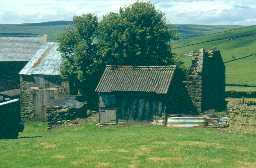Hayrake bastles (Allendale)
There are two bastles at Hayrake, one built onto the end of another. The earliest bastle dates to the late 16th or early 17th century and the second is slightly later. The two parts have identical fabric and wall thicknesses, being about 1.2m thick but the extended part now lies in ruins. There are several typical bastle features, including slit vents, or narrow openings, byre doorway with a massive stone lintel, and first floor doorway. Hayrake may have been the home of Quaker Thomas Williamston, who died in 1690 and is buried nearby. This is a Grade II Listed Building protected by law.
N7527
Post Medieval (1540 to 1901)
20th Century (1901 to 2000)
20th Century (1901 to 2000)
PHOTOGRAPHIC SURVEY, Towers and Bastles in Northumberland 1995; P RYDER
THEMATIC SURVEY, Towers and Bastles in Northumberland 1995; P RYDER
BUILDING SURVEY, Hayrake Bastle management plan 2009; North Pennines Archaeology Ltd
DESK BASED ASSESSMENT, Hayrake Bastle management plan 2009; North Pennines Archaeology Ltd
THEMATIC SURVEY, Towers and Bastles in Northumberland 1995; P RYDER
BUILDING SURVEY, Hayrake Bastle management plan 2009; North Pennines Archaeology Ltd
DESK BASED ASSESSMENT, Hayrake Bastle management plan 2009; North Pennines Archaeology Ltd
Disclaimer -
Please note that this information has been compiled from a number of different sources. Durham County Council and Northumberland County Council can accept no responsibility for any inaccuracy contained therein. If you wish to use/copy any of the images, please ensure that you read the Copyright information provided.
